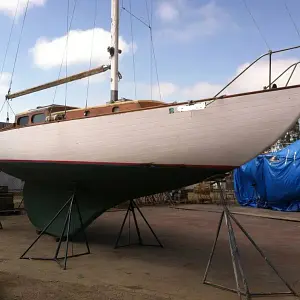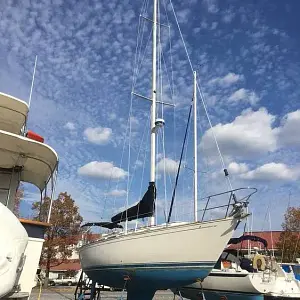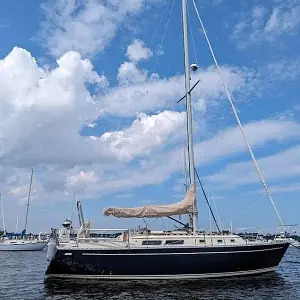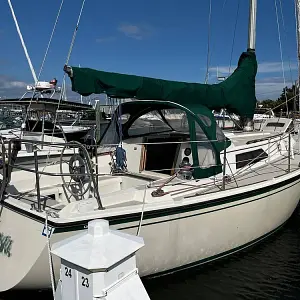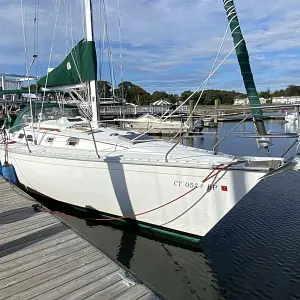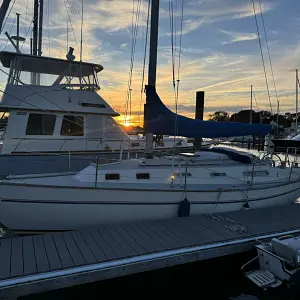Wooden Ships Comments on this Plymouth Hooker Known as a Plymouth Hooker, this is a typical West Country working boat with a transom stern, sweet sheer line and subtly aft raked stem, built by Pearce of Looe in 1908. Originally a fishing boat under the number PH107, she was worked until 1932 when she was converted to yacht. Since then she has been sailed as a yacht and has raced successfully in recent years under present ownership.Wooden Ships Comments on this Plymouth Hooker Known as a Plymouth Hooker, this is a typical West Country working boat with a transom stern, sweet sheer line and subtly aft raked stem, built by Pearce of Looe in 1908. Originally a fishing boat under the number PH107, she was worked until 1932 when she was converted to yacht. Since then she has been sailed as a yacht and has raced successfully in recent years under present ownership. Few boats can catch her especially with the big topsail set. A major rebuild was started by Devon boat builder John Moody who replaced the entire centreline in hardwood, including stem, stern post and deadwoods, all bronze through fastened. After this she was sold to the present owner who employed Cornish boat builder Peter Williams to complete the replacement of frames and all the planking. This work was completed in 2007 and since then she has been sailed and raced around the West Country where she has proved herself as a very fast boat and steals the show everywhere she goes. Length on deck 26’ Length Overall 36' Beam 9’ Draft 5’ Construction Planked in larch, all fastened with bronze nails to sawn oak frames. All planking new in 2007. Hardwood centreline with frown oak floors, all bronze fastened. External lead ballast keel with bronze keel bolts. Internal lead trimming ballast. Straight laid pine deck screw fastened to the deck beams. The foredeck dates from an earlier time. Aft and side decks new in 2007. Finished in non-slip grey deck paint. 6" bulwark all round on stanchions through the coverboards. Small coachroof with marine plywood coamings finished in gloss paint. Large centreline varnished sliding hatch makes for easy access to the cabin. Originally a half decker, she had a self draining cockpit fitted in 2007 with scrubbed teak thwarts. Rig Gaff cutter rig on a hollow keel stepped spruce pole mast. Varnished boom, gaff and bowsprit with lightweight jackyard for the big topsail. Galvanise standing rigging with dead eyes and lanyards to internal galvanised chain plates. Running back stays on 4:1 tackles Hanked on staysail to inner forestay. Jib on a traveller to bowsprit end. 2 pairs of Andersen self tailing cockpit sheet winches. Mainsail, staysail,working jib, blade jib , large and small topsail, 2 x asymmetric spinnakers. Machinery Volvo Penta moel 2003 3cyl 28hp marine diesel. Single lever control to centreline 2 blade bronze propeller 22 gallon plastic fuel tank in lazarette locker 2 x 12 volt batteries charged from the engine alternator. Accommodation Working boats were never known for large interior volume, however the addition of the coachroof has made the cabin of this boat a comfortable and useable space. Steps down from the hatch into the cabin. Aft T&G bulkhead with removeable panel for access to forrard end of the engine. A long settee berth either side in the main cabin provides comfortable seating under the deck head and good sized berths. Two child size quarter berths were fitted for the owners grandchildren, probably not suitable for another owner but can easily be removed. The starboard quarter berth doubles as a galley space with shelving and a portable gas burner. Starboard side of the mast is a storage unit, port side is a passageway through to the large forward double. Plenty of space for long weekend sailing, or for the more adventurous sailors this could easily be more long term accommodation! Full specification and details available upon request Disclaimer: These particulars have been prepared in good faith from information provided by the Vendors and are intended as a guide, Wooden Ships cannot guarantee or warrant the accuracy of this information nor warrant the condition of the vessel. The Purchaser should instruct his agent or surveyor to validate all details as necessary and satisfy himself with the condition of the vessel and its equipment.
